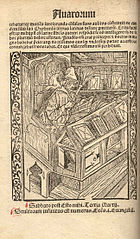Johann Geiler von Kaysersberg

Johann Geiler von Kaisersberg (March 16, 1445 – March 10, 1510), Swiss-born preacher, considered one of the greatest of the popular preachers of the 15th century.
He was born at Schaffhausen, but from 1448 passed his childhood and youth at Kaisersberg in Upper Alsace, from which place his current designation is derived. In 1460, Johann entered the Albert Ludwigs University of Freiburg in Baden Germany. After graduation, Johann lectured there for some time on the Sententiae of Peter Lombard, the commentaries of Alexander of Hales, and several of the works of Aristotle.
A living interest in theological subjects, awakened by the study of John Gerson, led him in 1471 to the University of Basel, a centre of attraction to some of the most earnest spirits of the time. Made a Doctor of Theology in 1475, Johann received a professorship at Freiburg in the following year; but his tastes, no less than the spirit of the age, began to incline him more strongly to the vocation of a preacher, while his fervour and eloquence soon led to his receiving numerous invitations to the larger towns.
Ultimately Johann accepted in 1478 a call to the cathedral of Strasbourg, where be continued to work with few interruptions until within a short time of his death on the roth of March 1510. The beautiful pulpit erected for him in 1481 in the nave of the cathedral, when the chapel of Saint Lawrence had proved, too small, stili bears witness to the popularity he enjoyed as a preacher in the immediate sphere of his labors, and the testimonies of Sebastian Brant, Beatus Rhenanus, Johann Reuchlin, Philipp Melanchthon and others show how great had been the influence of his personal character. His sermonsbold, incisive, denunciatory, abounding in quaint illustrations and based on texts by no means confined to the Bible, taken down as he spoke them, and circulated (sometimes without his knowledge or consent), by his friends, told perceptibly on the German thought as well as on the German speech of his time.

Among the many volumes published under his name only two appear to have had the benefit of his revision, namely, Der Seelen Paradies von waren und volkumen Tugenden, and that entitled Das irrig Schaf. Of the rest, probably the best-known is a seties of lectures on his friend Sebastian Brant's work, Das Narrenschiff or the Navicula or Speculum fatuorum, of which an edition was published at Strassburg in 1511 under the following title: Navicula sive speculum fatuorum praestantissimi sacrarumliterarum doctoris Joannis Geiler Keysersbergii.
References
- This article incorporates text from a publication now in the public domain: Chisholm, Hugh, ed. (1911). Encyclopædia Britannica (11th ed.). Cambridge University Press.
{{cite encyclopedia}}: Missing or empty|title=(help)
